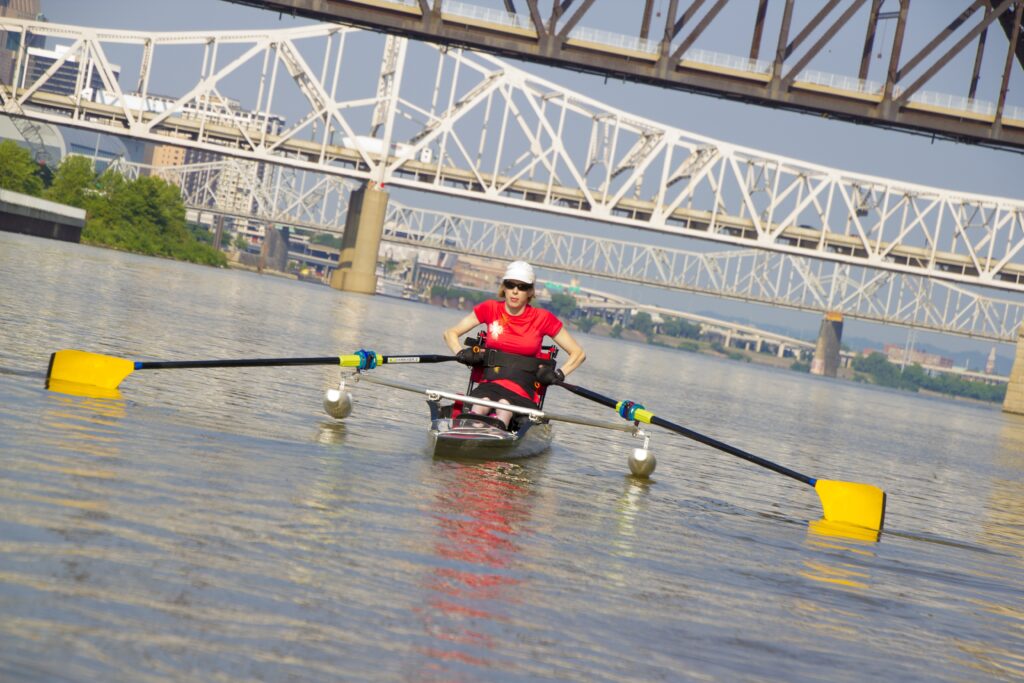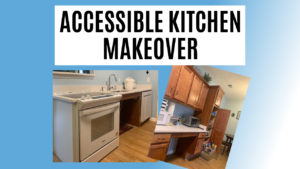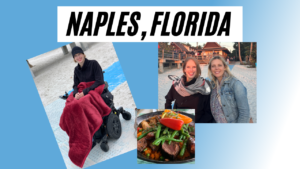As warmer weather with temperatures above 80 approaches, some of us with spinal cord injuries need to be prepared to prevent overheating. The autonomic nervous system controls temperature regulation. As a result, those of us with T6 injuries or higher can’t sweat or regulate our internal body temperature.
On a work trip in Granada, Spain, I was visiting the Alhambra, an ancient fortress and palace of the Moors. What should have been an incredibly awesome adventure was tainted by the 100˚+ Fahrenheit temperatures. I had a spray bottle and water with me. But at those temperatures, even well-prepared, the heat did a number on me.

So what can we do to stay cool when the temperatures outside (or inside) go up? Here are 6 ways I try to prevent getting overheated in the summer heat.
1. Wear the Right Clothing
Wear clothing like cotton or rayon or blends that breathe well. I’ve often thought the hotter it is, the fewer clothes I need. But I’ve discovered having my shoulders covered with loose-fitting sleeves helps me when I’m in the summer sun. I love “fluttery sleeves” that allow the breeze to touch my shoulders but protects them from the sun.
2. Bring on the Water
Since our bodies are made to cool down when sweat evaporates from our skin, we can mimic sweat by using wet washcloths, cooling towels or spray bottles. A wet washcloth around the neck, on my face, or the insides of my arms and wrists can help me stay cooler. Some people have great success with cooling towels, or handkerchiefs that cool down when you wet them. By constantly moving the wet towel or washcloth, you allow that water to evaporate, acting like sweat.
But the best advice I have is to get a spray bottle. In the past, I’d not want to soak down because of vanity. But when it’s hot, dousing yourself – head, neck, and upper body – is often the most effective means to imitate sweat. Pressurized spray bottles efficiently spray a good amount of water with little effort.
Drinking cold water makes me feel better, too. But be careful not to flush the electrolytes out of your system by drinking too much. Add Liquid IV to your water to stay properly hydrated.
3. Wear a Hat
Okay, hat-head is not attractive, but neither is nearly passing out or being grumpy from overheating. If I’m outside in the sun, I have finally come to terms with the benefits of wearing a hat to help keep me cool. I have a few white hats that not only reflect the sun but also protect my scalp from burning while playing sports. If I’m outside for a non-sporting event, I’m trying to have fun and get adventurous with a cute hat or two.
4. Ice and Ziploc® bags to Cool Off
If I’ve waited too long and I’m already over-the-edge hot, that’s when I break out the Ziploc® bags and a combination of ice cubes and water. I keep a few in my tennis and rowing bags. By placing the icy bags in key locations – the back of my neck, abdomen, carotid arteries on my neck, and the inside of my elbows and wrists – helps me begin to cool off, or at least prevents me from getting hotter.
5. Stop Before You’re Overheated
I love rowing in the summer. But even if I get on the river early in the morning, the heat and humidity can get to me within a short amount of time. I’ve learned to stop before I’m overheated. If I don’t, that extra 20 minutes of rowing will cost me several hours recuperating under a ceiling fan in bed, drenched in wet washcloths, drinking ice water. That extra 20 minutes on the water isn’t worth losing an entire afternoon recovering from the exhaustion I feel after overheating.

6. Avoid Hot Vehicles
I’m grateful to have a remote start on my van. When it’s really hot, I’ll try to remember ahead of time to start the van a few minutes before getting in since air conditioning often takes some time to get fully cool. Remember to be careful of seats, the steering wheel, or other objects that may cause burns if the temperatures are high.
More Tips to Prevent Overheating
Keep in mind the old adage “an ounce of prevention is worth a pound of cure.” Unfortunately, I’ve had to learn this the hard way (and still am not always successful). If you haven’t yet learned to read your body, here are a few tips from the school of hard knocks:
- Carry a thermometer. Know what your normal temperature is during different times of the day. If you are feeling warm, take your temperature and start to notice the signs of overheating for you. Everyone is different. For me, early signs of increased body temperature include my nose getting runny and stuffy. My face will flush. If I keep pushing it, I end up feeling miserable for hours.
- Be okay with your limits. I hate being the party-pooper and saying “no” to outdoor events or having different needs than my able-bodied friends. But I’ve learned that air conditioning, a spray bottle, and a wet, hat-haired-head is simply part of my life. And I’m (mostly) okay with that.
- Precooling. This is something I’ve been doing more often. Instead of soaking in the morning rays before getting in the boat to row, I stay in the shade or air conditioning on purpose to the point of being cool or cold until the last possible moment. Lowering my core temperature will offset my body’s warming trend once I’m active.
Remember that overheating can be deadly serious and can even bring on autonomic dysreflexia. And sometimes, it’s just wisest to stay indoors. Talk with your doctor about the dangers of overheating – or becoming hypothermic. Both are very real struggles for those of us with higher-level injuries.







